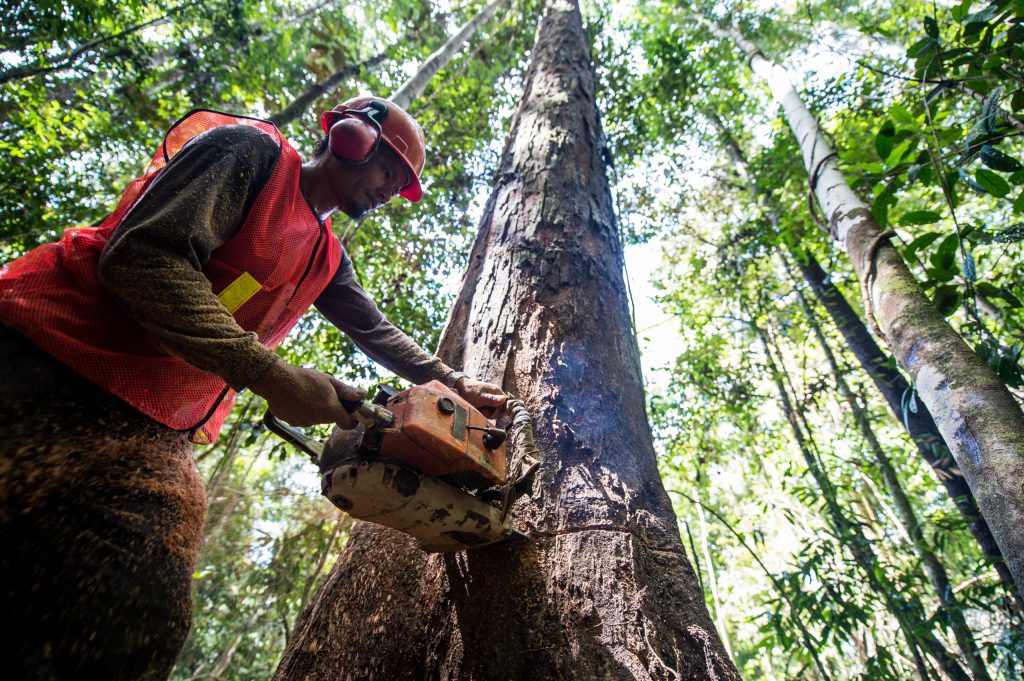New research from Borneo shows that the soundscape of a forest changes significantly following selective logging. The results have implications for safeguarding biodiversity in working forests.
The Gist
Scientists used acoustic recorders to monitor biodiversity before, during, and after selective logging in a tropical forest in East Kalimantan, Indonesia.
The results of their pilot study, published in Biological Conservation, showed an immediate and substantial decline in soundscape saturation after logging. This decline was driven by a loss of bird vocalizations, however, insect sounds stayed similar after logging. In a separate experiment looking at different sites that were logged a variable number of years ago, soundscape saturation recovered one year after logging and then fluctuated again.
The Big Picture
Half of the world’s tropical forests are selectively logged, where timber cutters harvest a small number of high-quality trees and leave the rest of the forest standing. Though these forests are degraded, research shows that they can still host large amounts of biodiversity, especially if loggers use low-intensity, reduced-impact logging techniques.
But what remains uncertain is how immediate the impact of logging is on biodiversity, how fast recovery happens, and how different logging practices, or post-logging management, influences the speed of recovery. Ecoacoustic recorders provide a low-cost, consistent monitoring tool that allows scientists to record the soundscape of a forest, which acts as a proxy for biodiversity.
The Takeaway
This pilot study is the first step towards understanding how biodiversity recovers immediately after selective logging. “Once we know exactly how much time is necessary for animals to come back, managers of selective logging concessions that are seeing a different, slower recovery, would know that something else is going on with biodiversity, and might be able to address it,” explains Zuzana Burivalova, a tropical forest ecologist at the University of Wisconsin-Madison and lead author on the research.
“For example, slow recovery could be due to an invasive species, or too much hunting.” she says. “At the same time, concessions managers that are re-logging an area too early might be more easily held accountable, when there is evidence that biodiversity has not yet recovered.”
Once fieldwork can resume, Burivalova and Nature Conservancy scientists would like to monitor post-logging recovery at a site for multiple years, as well as expand to tropical forests in other countries. Until then, the researchers are analyzing their existing data to identify which species are the first to return to logged areas.




Yes. I appreciate where you are coming from with your research regarding logging or in this case selective logging but, I truly feel that when anyone cuts a tree it really hurts the local ecosystem and community of other trees, ground shrubs and other local and accompanying plant life.
I am not sure if trees have feelings but I do believe they have souls. I also think trees are God or have a part of God in them like all people and all animals do. I think a tree is out there growing everyday next to a parent tree and/or sibling and a tree has a sense of pride as it grows and gets bigger and wants to make its family of trees proud of itself and each other.
I know it is true that trees talk or communicate with each other primarily by root connections but there may be other connections too, such as, a tree communicating with other trees and plant life through the air somehow. Trees together may be a family but trees are definitely friends of other trees as well as other local and accompanying plant life.
I think it is Wrong to cut trees down. In my opinion the only reason to cut trees is for protection from lightning and wildfire. asolomon777@gmail.com
The term “selective logging” doesn’t adequately describe the truth. A better term would be “high grade logging”, which is when the tallest, straightest, healthiest trees are cut, and the trees left behind are weaker, have smaller crowns, and may have inferior genetics. The long term result of high grading is the slow loss of biodiversity and resilience.